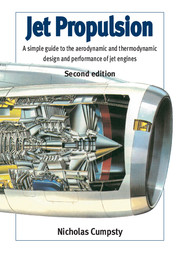 Jet Propulsion
Jet Propulsion Book contents
- Frontmatter
- Contents
- Preface
- Glossary
- Nomenclature
- Part 1 Design of Engines for a New 600-seat Aircraft
- Part 2 Engine Component Characteristics and Engine Matching
- 11 Component Characteristics
- 12 Engine Matching Off-design
- Part 3 Design of Engines for a New Fighter Aircraft
- Part 4 Return to the Civil Transport Engine
- Appendix: Noise and its Regulation
- Bibliography
- References
- Index
- Design sheets for New Large Civil Aircraft and New Fighter Aircraft
11 - Component Characteristics
from Part 2 - Engine Component Characteristics and Engine Matching
- Frontmatter
- Contents
- Preface
- Glossary
- Nomenclature
- Part 1 Design of Engines for a New 600-seat Aircraft
- Part 2 Engine Component Characteristics and Engine Matching
- 11 Component Characteristics
- 12 Engine Matching Off-design
- Part 3 Design of Engines for a New Fighter Aircraft
- Part 4 Return to the Civil Transport Engine
- Appendix: Noise and its Regulation
- Bibliography
- References
- Index
- Design sheets for New Large Civil Aircraft and New Fighter Aircraft
Summary
INTRODUCTION
Up to this point consideration has been given only to the design point of the engine. This is clearly not adequate for a variety of reasons. Engines sometimes have to give less than their maximum thrust to make the aircraft controllable and to maintain an adequate life for the components. Furthermore all engines have to be started, and this requires the engine to accelerate from very low speeds achieved by the starter motor. The inlet temperature and pressure vary with altitude, climate, weather and forward speed and this needs to be allowed for.
To be able to predict the off-design performance it is necessary to have some understanding of the way the various components behave and this forms the topic of the present chapter. It is fortunate that to understand off-design operation and to make reasonably accurate predictions of trends it is possible to approximate some aspects of component performance. The most useful of these approximations is that the turbines and the final propelling nozzle are perceived by the flow upstream of them as choked. Another useful approximation is that turbine blades operate well over a wide range of incidence so that it is possible to assume a constant value of turbine efficiency independent of operating point. These approximations make it possible to consider the matching of a gas turbine jet engine – how the various components operate together at the conditions for which they are designed (the design point) and at off-design conditions – and this will form the topic of Chapter 12.
- Type
- Chapter
- Information
- Jet PropulsionA Simple Guide to the Aerodynamic and Thermodynamic Design and Performance of Jet Engines, pp. 113 - 142Publisher: Cambridge University PressPrint publication year: 2003


